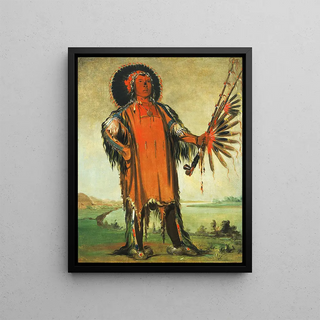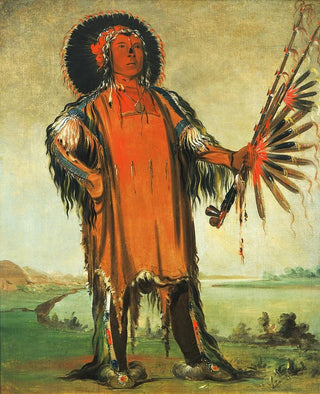Painting Ha-Na-T-Nu-Mak Wolf Chief Chef de la tribu - George Catlin | Art print


View from behind

Frame (optional)
In the vast panorama of art history, certain works stand out for their ability to capture the essence of a culture and immerse us in a bygone world. The art print Ha-Na-T-Nu-Mak Wolf Chief Chef de la tribu - George Catlin is a perfect example. This painting, which depicts a Native American chief, is not merely a visual representation. It evokes stories, traditions, and values of a people whose heritage is often overlooked. The power of this piece lies in its ability to establish a dialogue between the past and the present, allowing viewers to feel the vibrant soul of indigenous cultures.
Style and uniqueness of the work
George Catlin, as an artist, developed a unique style that combines realism and romanticism. In this piece, he employs a rich color palette and meticulous details that give striking depth to the depicted character. Ha-Na-T-Nu-Mak, with his penetrating gaze and traditional ornaments, becomes a living symbol of the pride and dignity of tribal chiefs. Catlin does not limit himself to a simple physical representation; he also captures the spirit and character of his subject. The textures of the clothing, carefully painted accessories, and background evoke the natural setting in which this iconic figure evolved. Every brushstroke seems to tell a story, every shadow and light adding an extra dimension to this masterful work.
The artist and his influence
George Catlin is often regarded as the first artist to dedicate his career to the representation of Native American cultures. His commitment to documenting these peoples, then facing cultural extinction, reflects a vision that is both artistic and humanist. Catlin traveled across the United States, meeting tribes, learning their customs, and seeking to immortalize their existence through his art. His work not only influenced his contemporaries but continues to inspire generations of artists and historians. By presenting portraits of chiefs and scenes of daily life, Catlin opened a window into a world

Matte finish

View from behind

Frame (optional)
In the vast panorama of art history, certain works stand out for their ability to capture the essence of a culture and immerse us in a bygone world. The art print Ha-Na-T-Nu-Mak Wolf Chief Chef de la tribu - George Catlin is a perfect example. This painting, which depicts a Native American chief, is not merely a visual representation. It evokes stories, traditions, and values of a people whose heritage is often overlooked. The power of this piece lies in its ability to establish a dialogue between the past and the present, allowing viewers to feel the vibrant soul of indigenous cultures.
Style and uniqueness of the work
George Catlin, as an artist, developed a unique style that combines realism and romanticism. In this piece, he employs a rich color palette and meticulous details that give striking depth to the depicted character. Ha-Na-T-Nu-Mak, with his penetrating gaze and traditional ornaments, becomes a living symbol of the pride and dignity of tribal chiefs. Catlin does not limit himself to a simple physical representation; he also captures the spirit and character of his subject. The textures of the clothing, carefully painted accessories, and background evoke the natural setting in which this iconic figure evolved. Every brushstroke seems to tell a story, every shadow and light adding an extra dimension to this masterful work.
The artist and his influence
George Catlin is often regarded as the first artist to dedicate his career to the representation of Native American cultures. His commitment to documenting these peoples, then facing cultural extinction, reflects a vision that is both artistic and humanist. Catlin traveled across the United States, meeting tribes, learning their customs, and seeking to immortalize their existence through his art. His work not only influenced his contemporaries but continues to inspire generations of artists and historians. By presenting portraits of chiefs and scenes of daily life, Catlin opened a window into a world
12,34 €






